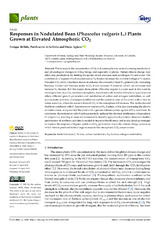Mostrar el registro sencillo del ítem
Responses in nodulated bean (Phaseolus vulgaris L.) plants grown at elevated atmospheric CO2
| dc.contributor.author | Bellido, Enrique | |
| dc.contributor.author | De la Haba, Purificación | |
| dc.contributor.author | Agüera Buendía, Eloísa | |
| dc.date.accessioned | 2023-05-25T11:31:32Z | |
| dc.date.available | 2023-05-25T11:31:32Z | |
| dc.date.issued | 2023 | |
| dc.identifier.issn | 2223-7747 | |
| dc.identifier.uri | http://hdl.handle.net/10396/25403 | |
| dc.description.abstract | The increase in the concentration of CO2 in the atmosphere is currently causing metabolomic and physiological changes in living beings and especially in plants. Future climate change may affect crop productivity by limiting the uptake of soil resources such as nitrogen (N) and water. The contribution of legume–rhizobia symbioses to N2 fixation increases the available biological N reserve. Elevated CO2 (eCO2) has been shown to enhance the amount of fixed N2 primarily by increasing biomass. Greater leaf biomass under eCO2 levels increases N demand, which can stimulate and increase N2 fixation. For this reason, bean plants (Phaseolus vulgaris L.) were used in this work to investigate how, in a CO2-enriched atmosphere, inoculation with rhizobia (Rhizobium leguminosarum) affects different growth parameters and metabolites of carbon and nitrogen metabolism, as well as enzymatic activities of nitrogen metabolism and the oxidative state of the plant, with a view to future scenarios, where the concentration of CO2 in the atmosphere will increase. The results showed that bean symbiosis with R. leguminosarum improved N2 fixation, while also decreasing the plant’s oxidative stress, and provided the plant with a greater defense system against eCO2 conditions. In conclusion, the nodulation with rhizobia potentially replaced the chemical fertilization of bean plants (P. vulgaris L.), resulting in more environmentally friendly agricultural practices. However, further optimization of symbiotic activities is needed to improve the efficiency and to also develop strategies to improve the response of legume yields to eCO2, particularly due to the climate change scenario in which there is predicted to be a large increase in the atmospheric CO2 concentration. | en |
| dc.format.mimetype | application/pdf | es_ES |
| dc.language.iso | eng | es_ES |
| dc.publisher | MDPI | es_ES |
| dc.rights | https://creativecommons.org/licenses/by/4.0/ | es_ES |
| dc.source | Plants, 12(9), 1828 (2023) | es_ES |
| dc.subject | Biofertilization | en |
| dc.subject | C:N ratio | en |
| dc.subject | Carbon metabolites | en |
| dc.subject | N2 fixation | en |
| dc.subject | Nitrogen metabolites | en |
| dc.title | Responses in nodulated bean (Phaseolus vulgaris L.) plants grown at elevated atmospheric CO2 | en |
| dc.type | info:eu-repo/semantics/article | es_ES |
| dc.relation.publisherversion | https://doi.org/10.3390/plants12091828 | es_ES |
| dc.relation.projectID | Junta de Andalucía. PAI Group BIO-159. | es_ES |
| dc.rights.accessRights | info:eu-repo/semantics/openAccess | es_ES |

